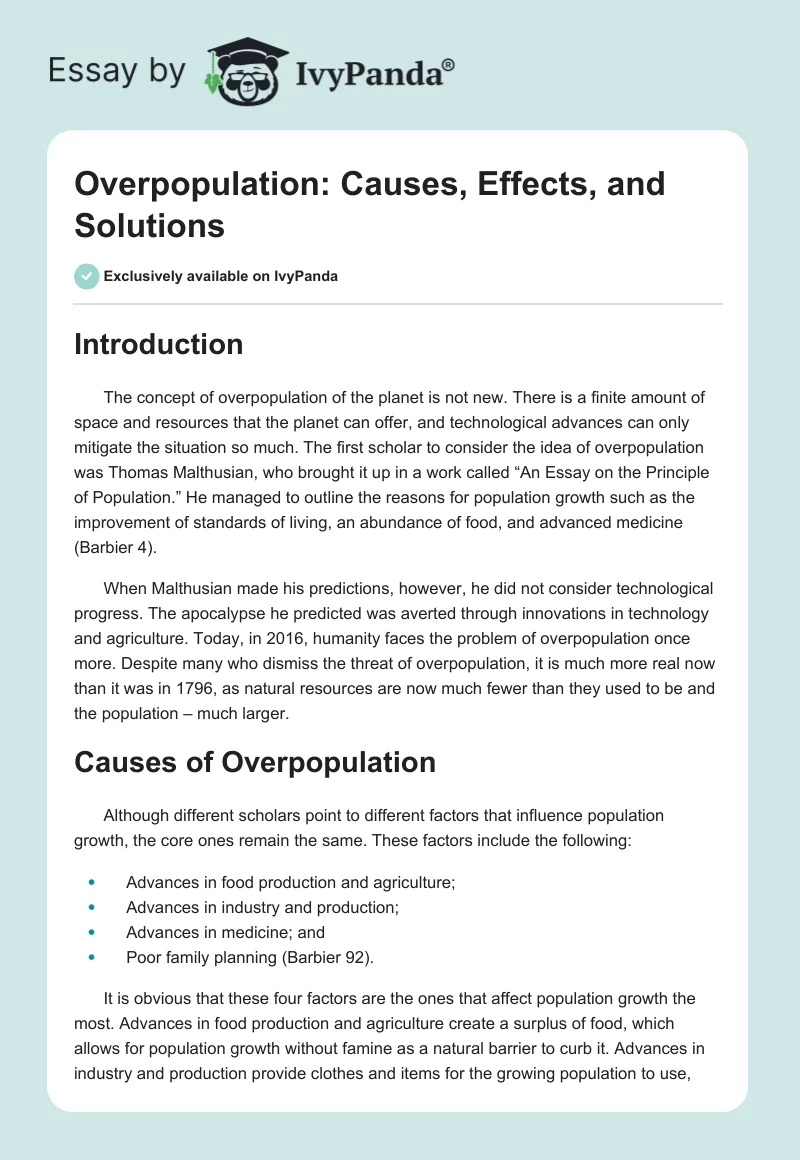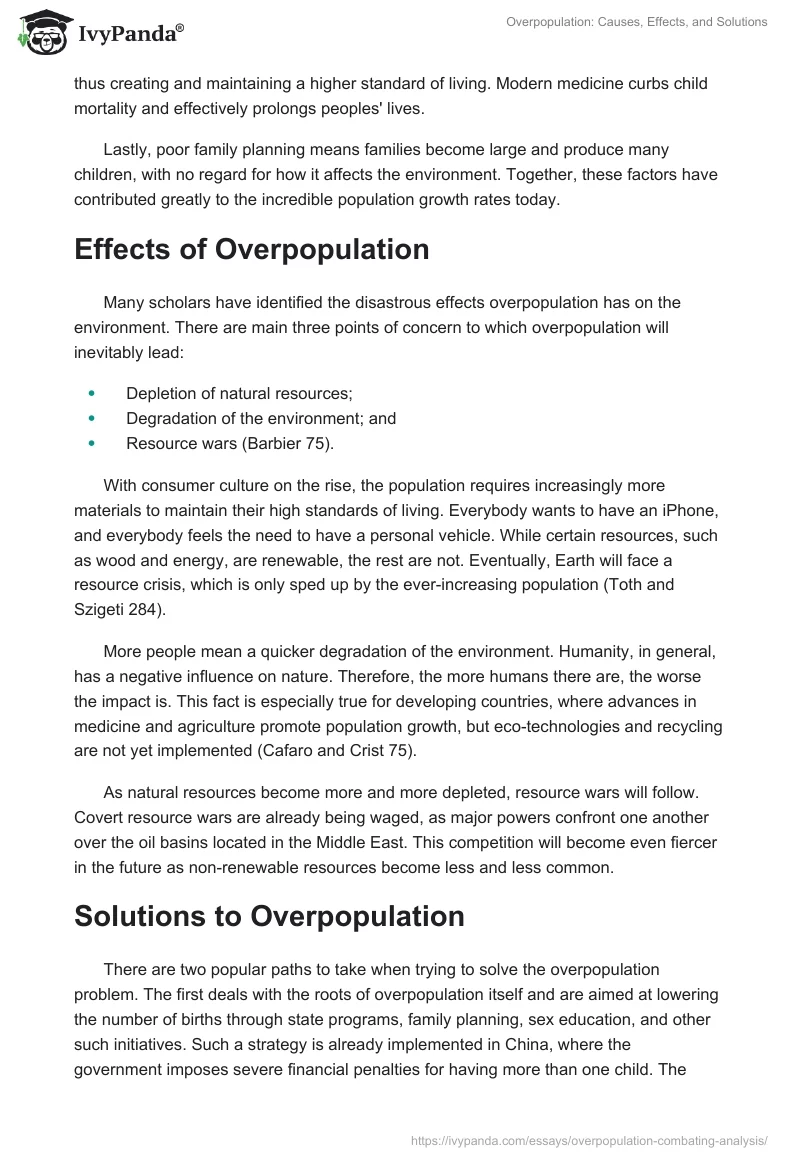Introduction
The concept of overpopulation of the planet is not new. There is a finite amount of space and resources that the planet can offer, and technological advances can only mitigate the situation so much. The first scholar to consider the idea of overpopulation was Thomas Malthusian, who brought it up in a work called “An Essay on the Principle of Population.” He managed to outline the reasons for population growth such as the improvement of standards of living, an abundance of food, and advanced medicine (Barbier 4).
When Malthusian made his predictions, however, he did not consider technological progress. The apocalypse he predicted was averted through innovations in technology and agriculture. Today, in 2016, humanity faces the problem of overpopulation once more. Despite many who dismiss the threat of overpopulation, it is much more real now than it was in 1796, as natural resources are now much fewer than they used to be and the population – much larger.
Causes of Overpopulation
Although different scholars point to different factors that influence population growth, the core ones remain the same. These factors include the following:
- Advances in food production and agriculture;
- Advances in industry and production;
- Advances in medicine; and
- Poor family planning (Barbier 92).
It is obvious that these four factors are the ones that affect population growth the most. Advances in food production and agriculture create a surplus of food, which allows for population growth without famine as a natural barrier to curb it. Advances in industry and production provide clothes and items for the growing population to use, thus creating and maintaining a higher standard of living. Modern medicine curbs child mortality and effectively prolongs peoples’ lives.
Lastly, poor family planning means families become large and produce many children, with no regard for how it affects the environment. Together, these factors have contributed greatly to the incredible population growth rates today.
Effects of Overpopulation
Many scholars have identified the disastrous effects overpopulation has on the environment. There are main three points of concern to which overpopulation will inevitably lead:
- Depletion of natural resources;
- Degradation of the environment; and
- Resource wars (Barbier 75).
With consumer culture on the rise, the population requires increasingly more materials to maintain their high standards of living. Everybody wants to have an iPhone, and everybody feels the need to have a personal vehicle. While certain resources, such as wood and energy, are renewable, the rest are not. Eventually, Earth will face a resource crisis, which is only sped up by the ever-increasing population (Toth and Szigeti 284).
More people mean a quicker degradation of the environment. Humanity, in general, has a negative influence on nature. Therefore, the more humans there are, the worse the impact is. This fact is especially true for developing countries, where advances in medicine and agriculture promote population growth, but eco-technologies and recycling are not yet implemented (Cafaro and Crist 75).
As natural resources become more and more depleted, resource wars will follow. Covert resource wars are already being waged, as major powers confront one another over the oil basins located in the Middle East. This competition will become even fiercer in the future as non-renewable resources become less and less common.
Solutions to Overpopulation
There are two popular paths to take when trying to solve the overpopulation problem. The first deals with the roots of overpopulation itself and are aimed at lowering the number of births through state programs, family planning, sex education, and other such initiatives. Such a strategy is already implemented in China, where the government imposes severe financial penalties for having more than one child. The country was forced to face the overpopulation problem earlier than most due to the unprecedented population growth it experienced in the decades prior.
The second route is not aimed at lowering the population but rather at providing for them. This approach involves recycling, using renewable energy, developing eco-clean technologies, and implementing other ideas that slow down and reduce the damage caused by the excess population. Looking for materials and resources outside the planet is futuristic, but it represents a viable strategy nonetheless. Eventually, humanity will have to look for resources in space, as it is impossible to create a completely self-sustaining resource model – some resources will inevitably be lost in the recycling process.
Combining both of these paths into one all-consuming strategy seems like the most reasonable and effective approach to mitigating the problem of overpopulation. Introducing statewide policies on birth control – in addition to popularizing recycling, using renewable energy, and minimizing the damage to the environment – would severely reduce the dangers presented by overpopulation and would buy humanity more time to find a permanent solution (Barbier 184).
Conclusion
As it stands, the effort to combat overpopulation is in its infancy. Outside of a couple of concerned governments who have to deal with overpopulation at home, nobody seems to give the issue the proper attention it deserves. If humanity is to overcome this problem, a united stance and a complex approach are required. This effort would require cooperation between different nations on all levels, as well as a vast informative campaign to make sure the general populace understands the need for such initiatives. Without such a joint effort, any local attempt to deal with the situation at home would have a limited effect.
Works Cited
Barbier, Edward. Economics, Natural-Resource Scarcity and Development, New York: Routledge, 2013. Print.
Cafaro, Phillip, and Eileen Crist. Life on the Brink, Environmentalists Confront Overpopulation, London: The University of Georgia Press, 2012. Print.
Toth, Gergery, and Cecilia Szigeti. “The Historical Ecological Footprint: From Over-Population to Over-Consumption.” Ecological Indicators 60 (2016): 283-291. Print.



